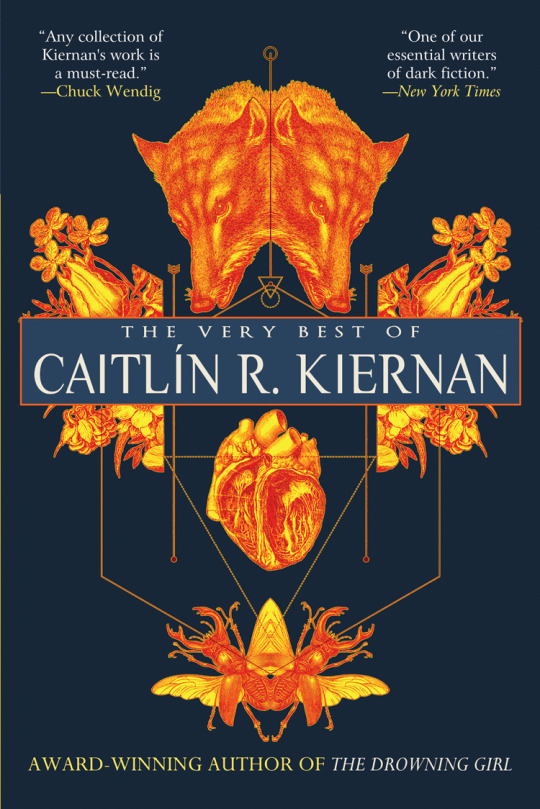THE VERY BEST OF CAITLÍN R. KIERNAN preview: “The Prayer of Ninety Cats”
In celebration for the release of THE VERY BEST OF CAITLÍN R. KIERNAN, Tachyon presents glimpses from some of the volume’s strange and macabre tales by the “reigning queen of dark fantasy.”

The
Prayer of Ninety Cats
by Caitlín R. Kiernan
With
no fanfare or overture, the darkness is split apart as the antique
projector sputters++ reluctantly to life. The auditorium is filled
with the noisy, familiar cadence of wheels and sprockets, the
pressure roller and the take-up reel, as the film speeds along at
twenty-four frames per second and the shutter tricks the eyes and
brain into perceiving continuous motion instead of a blurred
procession of still photographs. By design, it is all a lie, start to
finish. It is all an illusion.
There
are no trailers for coming attractions. There might have been in the
past, as there might have been cartoons featuring Bugs Bunny and
Daffy Duck, or newsreels extolling the evils of Communism and the
virtues of soldiers who go away to die in foreign countries. Tonight,
there’s only the feature presentation, and it begins with jarring
abruptness, without so much as a title sequence or the name of the
director. Possibly, a few feet of the opening reel were destroyed by
the projectionist at the last theatre that screened the film, a
disagreeable, ham-fisted man who drinks on the job and has been known
to nod off in the booth. We can blame him, if we like. But it may
also be there never were such niceties, and that this
35mm strip of acetate, celluloid, and polyester was always meant to
begin just
so.
Likewise,
the film’s score—which has been compared favorably to Wojciech
Kilar’s score for Campion’s The Portrait
of a Lady—seems to begin not at any proper
beginning. As cellos and violins compete with kettledrums in a whirl
of syncopated rhythms, there is the distinct impression of having
stumbled upon a thing already in progress. This may well be the
director’s desired effect.
EXT.
ČACHTICE CASTLE HILL, LITTLE CARPATHIANS. SUNSET.
WOMAN’S
VOICE (fearfully):
Katarína,
is that you?
(pause)
Katarína?
If it is you, say so.
The
camera lingers on this bleak spire of evergreens, brush, and
sandstone, gray-white rock tinted pink as the sun sinks below the
horizon and night claims the wild Hungarian countryside. There are
sheer ravines, talus slopes, and wide ledges carpeted with mountain
ash, fenugreek, tatra blush, orchids, and thick stands of feather
reed grass. The music grows quieter now, drums diminishing, strings
receding to a steady vibrato undercurrent as the score hushes itself,
permitting the night to be heard. The soundtrack fills with the calls
of nocturnal birds, chiefly tawny and long-eared owls, but also
nightingales, swifts, and nightjars. From streams and hidden pools,
there comes the chorus of frog song. Foxes cry out to one another.
The scene is at once breathtaking and forbidding, and you lean
forward in your seat, arrested by this austere beauty.
WOMAN’S
VOICE (angry):
It is
a poor jest, Katarína. It is a poor, poor jest, indeed, and I’ve
no patience for your games tonight.
GIRL’S
VOICE (soft, not unkind):
I’m
not Katarína. Have you forgotten my name already?
The
camera’s eye doesn’t waver, even at the risk of this shot
becoming monotonous. And we see that atop the rocky prominence stands
the tumbledown ruins of Čachtice Castle, Csejte
vára in the mother tongue. Here it has stood since
the 1200s, when Kazimir of Hunt-Poznan found himself in need of a
sentry post on the troubled road to Moravia. And later, it was
claimed by the Hungarian oligarch Máté Csák of Trencsén, the
heroic Count Matthew. Then it went to Rudolf II, Holy Roman Emperor,
who spent much of his life in alchemical study, searching for the
Philosopher’s Stone. And, finally, in 1575, the castle was
presented as a wedding gift from Lord Chief Justice Ferenc Nádasdy
to his fifteen-year-old bride Báthory Erzsébet, or Alžbeta, the
Countess Elizabeth Báthory. The name (one or another of the lot)
will doubtless ring a bell, though infamy has seen she’s better
known to many as the Blood Countess.
The
cinematographer works more sleight of hand, and the jagged lineament
of the ruins is restored to that of Csejte as it would have stood
when the Countess was alive. A grand patchwork of Romanesque and
Gothic architecture, its formidable walls and towers loom high above
the drowsy village of Vrbové. The castle rises—no, it sprouts—the
castle sprouts
from the bluff in such a way as to seem almost a natural, integral
part of the local geography, something in
situ, carved by wind and rain rather than by the
labors of man.
The
film jump-cuts to an owl perched on a pine branch. The bird
blinks—once, twice—spreads its wings, and takes to the air. The
camera lets it go and doesn’t follow, preferring to remain with the
now-vacant branch. Several seconds pass before the high-pitched
scream of a rabbit reveals the reason for the owl’s departure.
GIRL’S
VOICE:
Ever
is it the small things that suffer. That’s what they say, you know?
The Tigress of Csejte, she will have them all, because there is no
end to her hunger.
For more info about THE VERY BEST OF CAITLÍN R. KIERNAN, visit the Tachyon page.
Cover by Hannes Hummel
Design by Elizabeth Story
